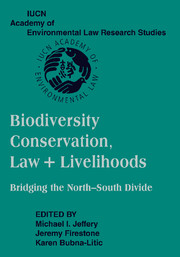 Biodiversity Conservation, Law and Livelihoods: Bridging the North-South Divide
Biodiversity Conservation, Law and Livelihoods: Bridging the North-South Divide Published online by Cambridge University Press: 31 July 2009
INTRODUCTION
From the first days of settlement in Australia until the present time, there has been conflict between private landowners’ rights to develop and community interest in sustainable land management and functioning ecosystems. Biodiversity is impacted by a multitude of actions taken daily by individual land managers, industries, communities, and governments. The long-term and cumulative effects of these individual actions in terms of native species and natural systems is difficult to track and manage. Many species at risk do not live in the protected areas of New South Wales (NSW) but on private land, and there are often, and inevitably, conflicts about what should be the appropriate activities carried out on such lands and waters. Are legal mechanisms the best way to resolve this conflict?
NSW has recently introduced comprehensive reforms to try to deal with these conflicts. These reforms cover all aspects of threatened species, native vegetation, and biodiversity planning. This chapter concentrates on the protection and assessment of threatened species and the certification process, leaving out those matters concerning the listing process.
Section 2 describes the background to these issues covering the historical context, the current state of biodiversity in NSW and what has happened in NSW in the past ten years since the introduction of the Threatened Species Conservation Act 1995. Section 3 identifies the challenges that would need to be addressed by the reform process.
To save this book to your Kindle, first ensure [email protected] is added to your Approved Personal Document E-mail List under your Personal Document Settings on the Manage Your Content and Devices page of your Amazon account. Then enter the ‘name’ part of your Kindle email address below. Find out more about saving to your Kindle.
Note you can select to save to either the @free.kindle.com or @kindle.com variations. ‘@free.kindle.com’ emails are free but can only be saved to your device when it is connected to wi-fi. ‘@kindle.com’ emails can be delivered even when you are not connected to wi-fi, but note that service fees apply.
Find out more about the Kindle Personal Document Service.
To save content items to your account, please confirm that you agree to abide by our usage policies. If this is the first time you use this feature, you will be asked to authorise Cambridge Core to connect with your account. Find out more about saving content to Dropbox.
To save content items to your account, please confirm that you agree to abide by our usage policies. If this is the first time you use this feature, you will be asked to authorise Cambridge Core to connect with your account. Find out more about saving content to Google Drive.